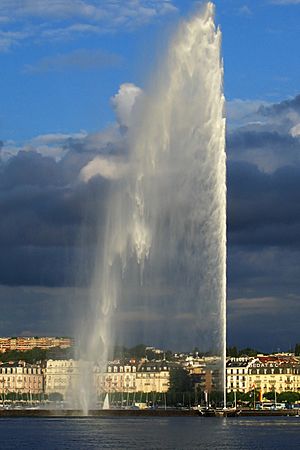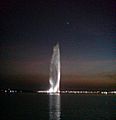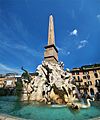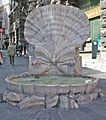Fountain facts for kids
A fountain is a special structure, usually built by people. It is designed to hold and display water from a source. Most fountains have a basin or pool where the water collects. Sometimes, water flows from one basin into another, creating a beautiful display. Many fountains also feature sculptures, making them works of art.
Some fountains use powerful jets to shoot water high into the air. This happens because of pressure, which pushes the water upwards.
Contents
What is a Fountain?
Fountains are structures that move water in a controlled way. They can be found in many places, like parks, town squares, and even inside buildings. Fountains are often used for decoration, making an area look more beautiful. They can also provide a calming sound from the moving water.
Long ago, fountains were very important for providing drinking water to people. Today, they are mostly used for art and enjoyment.
How Fountains Work
Most fountains work using a simple system. Water is usually pumped from a reservoir or a hidden tank. It then travels through pipes to nozzles. These nozzles are designed to shape the water as it comes out.
The water then falls into a basin or pool. From there, it is often recycled back through the system. This means the same water is used over and over again. Some fountains use strong pumps to create high-pressure jets. These jets can send water many meters into the sky.
A Look Back: History of Fountains
Fountains have been around for thousands of years.
Ancient Fountains
In ancient civilizations like Egypt and Mesopotamia, fountains were simple. They were often just natural springs or basins for collecting water. The Ancient Romans were very skilled at building aqueducts. These aqueducts brought water from far away into cities. This allowed them to build many public fountains. These fountains provided fresh water for everyone. They also decorated public spaces.
Medieval and Renaissance Fountains
During the Middle Ages, fountains became less common in Europe. However, they were still important in Islamic gardens. These gardens often featured fountains for beauty and to cool the air.
The Renaissance period in Europe brought back grand fountains. Wealthy families and rulers built amazing fountains in their gardens and palaces. These fountains often had complex sculptures and clever water tricks. The Villa d'Este in Tivoli, Italy, is a famous example. It has hundreds of fountains and water features.
Modern Fountains
In recent centuries, fountains have continued to evolve. They became popular in public parks and city squares. Many modern fountains use electricity to power their pumps. This allows for very tall jets and complex water shows. Some fountains even combine water with lights and music. These are called musical fountains. They create amazing performances.
Famous Fountains Around the World
There are many famous and beautiful fountains across the globe.
- The Trevi Fountain in Rome, Italy, is one of the most well-known. People often throw coins into it to wish for a return visit to Rome.
- The Jet d'Eau in Geneva, Switzerland, is a huge water jet. It shoots water up to 140 meters (459 feet) high.
- The Buckingham Fountain in Chicago, USA, is one of the largest fountains in the world. It has a grand water display with lights.
- The Dubai Fountain in the United Arab Emirates is another impressive musical fountain. It performs choreographed water dances to music and lights.
Fountains continue to be important parts of our cities and gardens. They bring beauty, sound, and a sense of calm to many places.
Images for kids
-
Attic Greek vase from South Italy, about 480 B.C.
-
Reconstruction of a Roman courtyard fountain in Pompeii (1st century AD)
-
Shalimar Gardens in Lahore, Pakistan (1641)
-
Fountain in Baku, Azerbaijan
-
The Fountain of the Court of the Lions in the Alhambra (14th century)
-
Fountain of Ahmed III next to Topkapı Palace in Istanbul, Turkey
-
The Fontana Masini in Piazza del Popolo in Cesena
-
Fontana di Trevi, the Trevi Fountain by Nicola Salvi, (1730).
-
The new Trafalgar Square fountains in London, with new pumps and lighting, opened in June 2009
-
The Splash Fountain in Krasnodar, Russia.
-
The book The Theory and Practice of Gardening by Dezallier d'Argenville (1709) showed different types of fountain nozzles which would create different shapes of water, from bouquets to fans.
-
Fountain nozzles which water gets cut off.
-
Fontana dei Quattro Fiumi by Bernini, (1648–51)
-
Triton Fountain by Bernini, (1642)
-
Samson and the Lion fountain at Peterhof Palace, Russia (1800–1802)
-
Fountain in the Place de la Concorde in Paris (1840)
-
Fountain in Trafalgar Square, (1845)
-
Bethesda Fountain in Central Park, New York City (1873)
-
Buckingham Fountain in Chicago (1933)
-
Fountain of Prometheus at the Rockefeller Center in New York City (1933)
-
The "Kissing Students" fountain at the Raekoja plats square near Tartu Town Hall in Tartu, Estonia (1948)
-
Fontaine de la Pyramide, Cour Napoléon of the Louvre, (1988)
-
Fountain at Raisina Hill, Rajpath near Rashtrapati Bhavan in Delhi (1929)
-
The musical fountain of the Bellagio Hotel & Casino in Las Vegas, with pivoting nozzles to vary the patterns of the water, controlled by computers and accompanied by music (1998)
-
Dubai Fountain in the United Arab Emirates (2009) can shoot water 150 meters in the air, or present computer-choreographed water dancing to music
-
The Fonte Gaia, Piazza del Campo, Siena, Italy by Jacopo della Quercia (1419) (replaced by a copy in 1868)
-
Fountain at Het Loo Palace in Apeldoorn, Netherlands
-
The Schöner Brunnen (Beautiful Fountain) in Nuremberg, Germany. (1385–96)
-
Samson and the Lion Fountain (1800–02), Peterhof, Russia
-
Buckingham Fountain (1927) in Chicago
-
The El Alamein Fountain (1959–61) in Sydney, designed by Robert Woodward, was the first "dandelion" fountain
-
The Emil Aaltonen Memorial (1969), a 4.5 metres (15 ft) tall fountain at the Tammela Square in Tampere, designed by Raimo Utriainen
See also
 In Spanish: Fuente (arquitectura) para niños
In Spanish: Fuente (arquitectura) para niños




























































